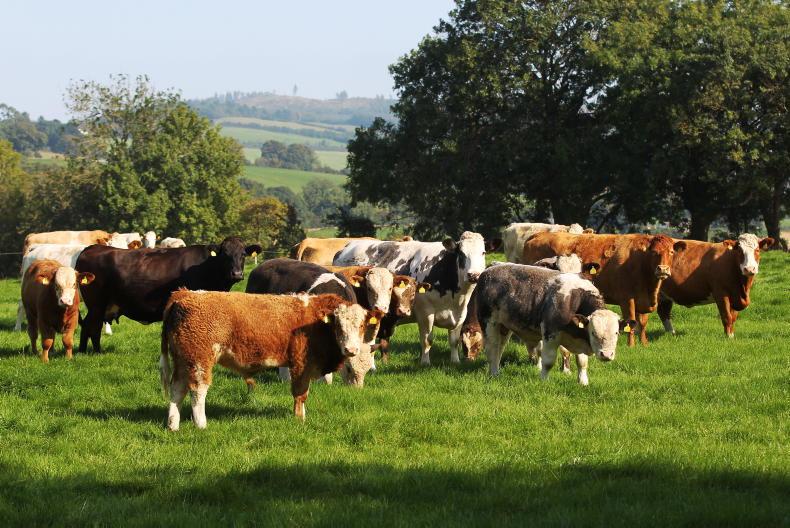The last 12 months will go down as a pretty positive year for beef and suckler farmers, with the second half of 2024 being particularly positive for the beef sector.
Yes, there are some big challenges including reduced supports; succession and who the next generation of farmers will be; the high cost of doing business; and the impending threat of the Mercosur trade deal being ratified at some point in late 2025.
All that said, there is also a lot to be positive about in the Irish beef industry. Let’s take a look at five reasons why 2025 could be a good one for beef farmers.
1Beef price: they say a rising tide lifts all boats, and that’s certainly the case for beef price and the general cattle trade in marts.
According to Bord Bia, the average beef price for an R3 bullock for 2024 up until 7 December comes in at €5.43/kg, up 20c/kg on the previous year’s price of €5.23/kg.
The last 12 months have been the best in terms of beef price in the last 10 years, and it’s finishing on a high with the average R3 bullock price for the week ending 7 December coming in at €5.78/kg.
In the last year, the UK R3 bullock price has risen by €1/kg with the Irish price now lagging behind by €1.05/kg — a huge gap. The R3 European young bull price is currently running 10c/kg ahead of the Irish price.
Current indications are based on supply and demand that beef prices will improve in 2025 with tighter numbers of finished cattle available for sale across the UK and Europe. Higher numbers of store cattle exports will also feed into reduced supply in Ireland.
2Live exports: live exports took a huge jump in 2024 with very high demand from north African countries, with Morocco standing out as the star performer of 2024.
There have also been solid numbers of weanlings exported to Italy with good numbers of lighter-type calves also moving to Spain.
Weanling exports will finish the year over 70% higher than the 2023 figure. Weanling exports have been helped by the spread of bluetongue across Europe with traditional suppliers of weanlings locked out of markets due to movement restrictions.
Store cattle exports have also seen a dramatic rise in 2024 with exports up nearly 60% on the 2023 figure.
Northern Ireland has seen a 5.5% rise in store cattle imports from the Republic of Ireland and with finishing numbers tightening that looks to continue well into 2025. The only fly in the ointment is calf exports.
The Netherlands took 33,547 less Irish calves in 2024 and the decline looks set to continue in 2025.
On a positive note, other new eastern European markets have opened up, with Poland taking 8,586 more calves in 2024 — up 50% on the 2023 figure.
The high live export figure will bode well for beef price in the coming years as supply and demand continues in the farmer’s favour.
3Weanling trade: the live export trade has driven on the price of weanlings in the last six months, with some exceptional prices being paid for top-quality weanlings. It’s not just the top weanlings that are in demand with exporters having several contracts to fill for different qualities of cattle for different countries. This has meant there have been many shootouts around mart rings with farmer buyers and exporters clashing for weanlings and driving prices up.
Irish Farmers Journal MartBids analysis shows that top-quality Charolais-cross bull weanlings came in at €3.90/kg in 2024, up from €3.65/kg in 2023 and up from €2.83/kg in 2020. That’s a €374/head rise in the last five years. Mart managers are forecasting a strong start to the 2025 cattle trade, with some concern around actually sourcing sufficient quality store bullocks given the level of weanling and store exports that took place in the latter half of 2024.
4Suckler numbers: while many feel that dropping suckler numbers are a bad thing for the industry, there are some people who feel the lower numbers could help underpin the trade, especially for better-quality weanlings.
Speaking to a few mart managers over the last few months, they feel that the lower numbers has raised the demand for good-quality weanlings.
There are only so many top-quality weanlings, so buyers are willing to go those extra few bids to get them. This has meant suckler farmers at the top of their game have been well rewarded for breeding quality weanlings, the way it should be.
While a declining suckler herd is a huge concern for Ireland’s image as a beef-producing nation, it could mean higher prices for those that stick with it.
5Positivity: it’s been a long time since we have had such positivity in the beef industry. A good autumn in 2024 has put to bed any fears on fodder and suckler farmers are genuinely looking to 2025 with some hope and optimism.
Yes, costs are still high and supports into the sector have dropped, but good prices can overcome some of this. Speaking to farmers around the country over the last few months, they feel suckling is in a good place at the moment with the weanling trade and general cattle trade lifting spirits in beef circles.
The general positivity has filtered into the replacement heifer trade with good interest in suckling circles for good-quality replacement heifers.
While it’s a specialised system everybody continues to talk about the Winter Fair in Carrick-on-Shannon in November. The number of young people — both male and female — attending this year’s event was also a big talking point.
It’s great to see the next generation getting involved in showing cattle and if this filters into looking after livestock and general suckling farming, it has to be good.
It’s not a road for everybody to go down, but a lot of these producers run just a few high-end animals alongside a traditional suckler herd.
